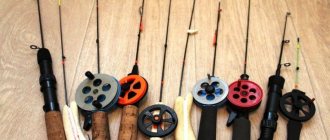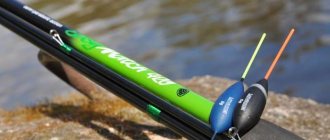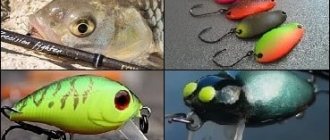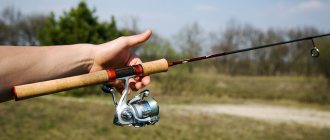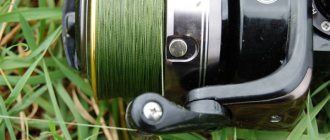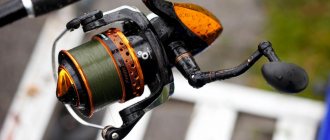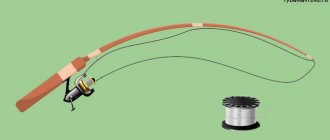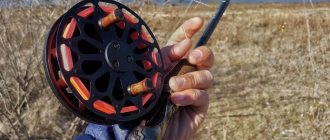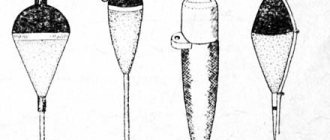Fishing rod
So, a fishing rod is a piece of equipment mainly used for fishing at a short distance from the shore and does not require any special handling skills.
Modern fishing rods are made from polymer materials that have strength, lightness, ductility and flexibility. They consist of several elbows that allow you to adjust the length of the rod and the casting distance of the tackle.
There are fishing rods made from bamboo, but they are not compact compared to telescopic fishing rods, since they are attached to each other by inserting the knees into one another.
Bamboo fishing rod
Structurally, all fishing rods are the same and consist of:
- Rods
- Coils (inertial or non-inertial).
- Equipment (line, float, sinker, hook).
Depending on the fishing conditions, the following types of rods are used:
- Flywheel - designed for simple fishing from the shore, or on the lake in places with difficult access to the water.
- Feeder - a special fishing rod, the equipment includes a feeder with feeding attached next to the hooks. It has proven itself well when fishing in strong currents.
- A match rod is the longest rod, used when fishing at a considerable distance from 20 to 70 meters from the shore.
- Bolognese is a universal rod used for fishing at various distances and in any water.
Usually small fish weighing up to 5 kg , with the exception of match rods, which are used for catching fish weighing up to 15 kg.
Where are fishing rods used?
A fishing rod is a universal tackle. It can be used on any reservoir, regardless of fishing conditions. I use it when fishing from the shore and boat, on small and large rivers, on ponds and lakes, quarries, toad fields and forest swamps.
A properly configured float rod allows you to consistently catch heavy fish
With a fishing rod you can fish on the pond from a boat or shore, successfully hunting for crucian carp and tench. It is used when fishing for rudd and roach in windows of aquatic vegetation. This tackle will not let you down in the current when fishing for silver bream, bream, ide and undermouth.
How to assemble a spinning rod correctly
Some fishermen use fishing rods to equip bottom gear, which is popularly called a weight. It looks like this:
- Take a rod about 4–5 meters long.
- A fishing line with a thickness of about 0.3 mm and a length of 1–1.5 meters longer than the rod is attached to it.
- A sliding sinker is placed on the fishing line. Most often, its role is played by a banal “olive”.
- The load is secured from below with a lead pellet.
- A leash of 20 to 50 cm is tied to the free end of the main thread.
- A single hook is attached to the leash.
That's it, the truck is ready. As a rule, such tackle is used in coastal holes and ditches. The hook is equipped with a leech, a large worm, a frog, and live bait. The catches include catfish, burbot, heavy perch, bream, carp, and ide.
As you can see, a fishing rod is a tackle for catching peaceful fish. However, some fishermen use it to hunt predatory underwater inhabitants. This approach increases mobility, unlike classic donks, and increases the dynamics of fishing, allowing you to fish a large area of water.
The most common tackle for predators is a running donka. In essence, it is a fly fishing rod with or without a float and equipment for small baitfish or dead fish. The fisherman moves along the shore, throwing bait to promising points. The bulk of the catch with this approach is medium-sized perch and pike up to two kilograms.
Spinning
Fishing with a spinning rod is done by long-distance casting of a spinner and its further retrieval. The structure of a spinning rod is similar to a fishing rod; it also consists of a rod, reel and fishing line with equipment.
There are composite and telescopic fishing rods; the first type is durable and reliable, but the second is quite compact. The materials for the production of fishing rods are carbon fiber and fiberglass.
Spinning rods differ from each other in such performance properties as:
Length - varies from 2.1 m to 2.7 m, and depends on the method and place of fishing:
- 2.1 meters, used on narrow rivers with regular changes of bite location.
- 2.4 meters, used when fishing from a boat.
- 2.7 meters, for casting to maximum distances on large bodies of water.
Test - the maximum and minimum weight of the bait, allowed for use in conjunction with a fishing rod without overloading it/
Class - depends on the weight of the rod and can be:
Action is the bend of a loaded rod.
- Fast (the load is taken by the tip).
- Medium (half the rod is loaded).
- Slow (the entire rod is under load).
Having a reserve of high strength and a moving bait in the form of a spoon or wobbler, spinning rods are used to catch heavy predatory fish.
Features of the spinning rod
Today, spinning is the most popular tackle that has a huge number of fans. With its help, they hunt all types of predatory, semi-predatory and some peaceful fish. It allows you to fish everywhere, from a small stream to an endless reservoir.
Spinning allows you to catch predators in any body of water
Structurally, spinning rods differ from float rods. Their length ranges from 1.6 to 3.6 meters. The blank is made of carbon fibers. There are pass rings installed on it. In the butt part there is a cork, neoprene or combined handle, which is equipped with a reel seat.
In addition to the spinning rod, the main element of the gear is a spinning or multiplier reel mounted on the handle. With a line wound on a spool and a bait tied at the end of the thread, the kit turns into a formidable weapon for catching predatory fish.
Most spinning rods have a plug-in design. As a rule, these are two-part rods consisting of a butt and a tip. There are dimensional single-pieces with a solid blank or, conversely, compact “rods” of three, four or five sections.
Note! Telescopic spinning rods are less popular because they are inferior to plugs in many respects. They are relevant as a fishing rod for travel, business trips and blitzes on the pond.
All spinning rods can be distinguished by their performance characteristics. The main ones are:
- length;
- bait test;
- build.
Telescopic spinning rod is compact, lightweight, takes up little space
You also need to pay attention to the weight of the spinning rod and its balance. An important factor is the price of the product. Good quality fishing rods cannot be cheap, since they are made of carbon fiber and equipped with high-quality fittings.
Feeder, casting, fishing rod: how do spinning rods differ?
The difference in spinning rods can be quite significant and depends on the fishing method and the fish being hunted. Even in different regions of Russia, a variety of fishing rods are used. For example, in the northern regions they use powerful whips, which is due to the catching of large and active fish - salmon, taimen.
In the coastal zone, among aquatic vegetation, completely different fishing rods are used. Carp fishing requires other characteristics for the form. That is, it is impossible to get by with some kind of universal fishing rod, because otherwise fishing will simply be unsuccessful. The difference between one type of spinning rod and another is fully justified by centuries of experience and practice.
The problem of choice: what is the difference between a spinning rod and a fishing rod
Having asked the question: is the difference between a spinning rod and a fishing rod significant or not, let’s try to remember what kind of fish they are intended for catching. Spinning is used to catch predatory fish using artificial bait. The length of the whip is from 1.8 to 3.3 m. Test and action depend on the fishing method. For example, for trolling (dragging bait behind a boat), the length of the rods is short, but they have a high test to cope with strong fish.
For fishing for peaceful fish, the difference between a spinning rod and a fishing rod becomes clear. The concept of “fishing rod” hides a variety of fishing designs, used, again, depending on the conditions. Even an ordinary float is divided into several categories.
Fly fishing rods are designed for fishing close to the shore. Often they do not have passage rings and, accordingly, a coil. The fishing line is attached to a special ring located at the end of the rod. The length of such fishing rods ranges from 3 to 8 m.
For long-distance casting, match rods with a plug connection method are used - joining the knees. They are equipped with a large number of guide rings located on high stands to prevent the fishing line from sticking to the rod. They are made up to 5 meters long for efficient long-distance casting.
Design features of the gear
Casting spinning rod for twitching or jig fishing includes the following elements:
- A durable fishing rod with increased sensitivity, low weight and a length suitable for specific conditions. This form includes: a fishing rod, a reel holder, a handle, and guide rings. As for the type of such rods, they can be plug-in or telescopic. Experienced fishermen prefer the first type, because the second has many advantages.
- A baitcasting reel capable of fighting the heaviest fish, weighing up to 60 kg, while remaining sensitive, multifunctional and versatile regarding the bait used. A distinctive feature of such products is the absence of twisting of the fishing line when winding onto a reel. With its help, you can make long casts with almost any thickness of thread. Narrow-profile and wide-profile models are available for sale. The first option is suitable for baits weighing 10-20 grams, and the second - for heavy ones that weigh from 40 grams. In addition, there are devices that are designed only for jerkbaits, heavy jig baits and large wobblers, and reels used for sea fishing with heavier products.
- Fishing line. As a working line for this gear, it is advisable to use a special cord, which demonstrates maximum resistance to prolonged use and maximum loads. Such cords are quite rigid and practical to use.
Form performance characteristics
To make the right decision and choose a quality model, it is important to carefully study a number of features:
Material of manufacture. Modern companies that produce casting rods use several materials for their manufacture. Among them: fiberglass, carbon, graphite and synthetic fibers. Fiberglass models are characterized by great strength and flexibility, but their weight remains impressive. Carbon products are resistant to increased loads and have a high degree of resistance. The advantage of graphite is maximum hardness and rigidity, which has a positive effect on strength properties. Build. Casting fishing rods can have different structures. There are models with parabolic and semi-parabolic action, as well as options that bend at the top and bottom. For a beginner, it is advisable to use the first two types. Test range. Fishing rods can have different test loads and are divided into several classes: heavy casting - suitable for 40 gram baits, heavy medium - for baits up to 27 grams, medium casting - up to 21 grams, light medium - up to 20 grams. Passing rings
It is important to note that the rings on casting rods differ from others in their small diameter and low stem. Rings on casting rods
Important rod parameters
As for the optimal rod length, it is chosen taking into account the fishing conditions and fishing method. In this case, you should adhere to the following recommendations:
- When catching predatory fish from a boat or when casting along the coastline, you should use short fishing rods, the length of which is 180-200 centimeters. They allow you to successfully monitor the behavior of the nozzle in a specific water area and demonstrate maximum sensitivity.
- For boat and shore fishing, regardless of the type and nature of the reservoir, fishing rods with a medium length are suitable. They are considered a versatile and convenient tool that is ideal for beginners who have no experience in handling casting gear.
- Models with a length of 2.2-2.9 meters are suitable for fishing from banks and bridges. The use of long poles makes it possible to make long casts and fish large areas of water.
It is also important to take into account such a parameter as the power of the casting form
- If you are going to fish with baits that weigh up to 20 grams, then light models equipped with a thread with a permissible load of up to ten kilograms are perfect.
- If products weighing up to 50 grams are used as bait, then it is advisable to take a middle-class form, which is equipped with a fishing line with a permissible load of up to 15 kilograms.
- And if we are talking about catching larger prey, for example, sea fish, using heavy baits, then it is better to find a heavy tool, and use a thick thread with a load of up to 22 kg as a working line.
Is the difference between a spinning rod and a feeder really that significant?
Both of these rods are characterized by the following indicators: test, action, length. We talked about these indicators in the article “How to properly organize spinning fishing for predatory fish.” If we briefly decipher these indicators, the form test indicates the maximum loading weight of the gear, the action indicates the ability to bend under the influence of load, the length of the rod directly affects the delivery distance of the bait.
The first thing that distinguishes a spinning rod from a feeder rod is its length – it is somewhat shorter. Spinning fishing is more active, so casting bait should be more comfortable both from the shore and from the boat. During one fishing trip, the form has to be rethrown hundreds of times; therefore, special attention is paid to the lightness of the gear.
Another factor that distinguishes a feeder from a spinning rod is that the feeder rod is equipped with replaceable tips, the so-called quivertips. They do not participate in casting the tackle and serve as a bite alarm. Spinning tackle does not use a similar design; the bite is felt by the angler’s brush.
The tips are divided according to the degree of sensitivity:
- For fishing in still water or in light currents, soft tips are used;
- medium ones are used for faster water movement or strong wind;
- a significant current forces you to set up the tackle with rigid quivertips.
Both types of fishing rods are currently made from the same components: fiberglass, carbon fiber, composite materials. The most expensive blanks are made of carbon with a cork handle.
The difference between a fishing rod and a spinning rod
Beginning fishermen are often faced with the problem of choosing one or another fishing tool, because they may not even know how a spinning rod differs from a fishing rod. You only need to choose between a fishing rod and a spinning rod based on the methods and methods of fishing.
The popularity of spinning fishing has begun to increase sharply in recent years. Spinning rods are made from various materials, most often carbon fiber, fiberglass and composite materials (a combination of coal, glass and plastic).
And ordinary fishing rods will not lose their relevance for many years; they can often be seen among fishermen on the banks of reservoirs. Fishing stores also have a wide variety of different fishing rods.
Fishing rods are classified according to different parameters:
- to size;
- by weight;
- by the presence of a coil;
- by fishing method (match, plug and fly).
- Main features of the fishing rod
- Basic knowledge about spinning
- Differences between a spinning rod and a fishing rod
Main features of the fishing rod
Fishing is one of the most exciting activities, so today many companies have developed various types of equipment, choosing which even the most experienced angler can get confused.
Therefore, it is recommended that beginners prefer a fishing rod or spinning rod to begin with. There are similarities between a spinning rod and a fishing rod, but they also have serious differences.
In addition, they have a number of advantages that are worth getting to know.
So, a fishing rod is used when fishing does not involve a long distance from the shore. In addition, such tackle does not require special knowledge when handling.
Fishing rods made from bamboo can also be sold, but such products are considered non-compact, since when they are attached, the knees are inserted into one another. In this they can differ significantly from telescopic rods.
As for the design, each fishing rod consists of a rod, reels, as well as tackle, in particular, fishing line, floats, hook, and sinker.
When choosing a fishing rod, a lot depends on the place where you are fishing.
There are several types of fishing rods:
- For fishing from the shore you need a fly rod. It is also suitable for a lake if access to water is difficult.
- In strong currents, you should prefer a feeder fishing rod, the equipment for which includes a feeder and feeding material attached near the hooks.
- The longest fishing rod is considered to be a match rod; it is used during fishing at a serious distance of up to 70 m directly from the shore.
- Bolognese is universal and can be used in almost any conditions.
The main difference between spinning and casting
There are several signs to understand the difference between a casting rod and a spinning rod. For example, the diameter of the passage rings is small; they are mounted on a low stand. But the number of rings has been slightly increased and they have been moved to the other side of the rod in relation to the reel. The casting form is equipped with a multiplier reel.
Multipliers are used on somewhat powerful whips, which is why by increasing the number of guide rings the rod is unloaded more evenly. The multiplier is an improved type of conventional inertia-free gear; its operation is based on the principle of a winch. The use of a multiplier reel is due to the large mass of bait when casting.
Now let’s try to consider not how a casting spinning rod differs from a regular one, but what their similarities are. Perhaps there is only one thing: spinning rods are determined by test and structure. The casting pattern is also determined by the fishing conditions. If you will be jerking with persistent baits, you will need a short and rather rigid blank.
According to the test, casting rods are divided into light, medium and heavy. What is the difference between spinning and casting - the weight range of baits is up to 200 grams. Heavier ones can also be used, which are used in sea trolling to catch large fish. However, light baits are also successfully used: wobblers and jig heads.
Experienced fishermen give many arguments in favor of casting tackle, considering the possibility of feeling a bite with the finger of the hand, which lies on the braided cord, as a significant advantage. Fishing with a multiplier is much more comfortable. The disadvantage is the inability to cast very light types of bait.
The best cheap spinning rods for jigging
We present a review of plug-in and telescopic spinning rods for jigging, which are in greatest demand among Russian consumers.
ZEMEX Spider Pro 270 5-28g fast takes first place and is suitable for anglers who are just starting out. The model is suitable for both light and heavy baits. Most often chosen for catching perch. This is a universal option at an affordable price, which has a beautiful appearance, is durable and casting accurately.
In second place is Maximus Wild Power-X SWPX27H. This model is distinguished by high quality, light weight, affordable price and durability. In third place is Aiko Troutex TRO180UL. It is characterized by a rigid structure, an ergonomic handle, and has good sensitivity, but sometimes the line gets caught between the rings.
What is the difference between a spinning rod and a fishing rod? Beginner's Guide
Of course, today fishing is more of a pleasant pastime in the fresh air, and not a way of obtaining food, as it was with our ancestors. This fact does not prevent millions of people on Earth from having an excellent hobby and truly loving fishing. But this process requires certain skills and theoretical knowledge, especially for a beginner. This material will tell you about the difference between a spinning rod and a fishing rod. After all, the main devices for catching a trophy are still these two popular tackles.
The most important characteristics of a spinning rod
When purchasing a spinning rod, you should consider its structure. It comes in fast, medium and slow. This parameter shows how the spinning rod bends under load. With a fast action, only the upper part of the spinning rod bends. When slow, the spinning rod bends evenly almost from the handle itself. A spinning rod with a medium action has intermediate characteristics.
Another important characteristic of a spinning rod is its lure test. For example, test 1-5 indicates that the spinning rod can work with the lightest baits from 1 to 5 grams. Spinning rod with 5-25 test can be called universal; it is suitable for a wide range of baits.
Build and test are also typical for fishing rods; manufacturers always indicate these parameters in their description.
Fishing rod as a means of fishing
According to historians and fishing researchers, the prototype of the fishing rod appeared in time immemorial in the ancient world, when man began hunting fish. With its help, food was actually obtained, and the fishing profession was equated to hunting and was highly revered. Of course, since then the float rod itself has undergone many modifications and improvements. For example, flexible tree branches were previously used as fishing rods, then bamboo, then plastic. And the rod became extendable, the fishing line was threaded into convenient rings. But the fact remains: its main functions remained, in principle, the same as many centuries ago. What is the difference between a fishing rod and a spinning rod, what is the difference between these two tackles? Let's figure it out.
Spinning fishing
It is believed that this tackle revealed itself to the world in England. By the way, at first the fishermen there cast a spinning rod into the line without the help of reels. The fishing line was simply pulled together by the fisherman and folded, for example, between the legs. And when casting, it passed through the rings, rising from the ground. In general, the spinning rod was more like a float fishing rod, but with a long, very long line. Coils began to be included in the design only in the 19th century. With the invention of the inertial reel, working with a spinning rod became much easier, and it became a more popular piece of equipment. And when inertialess reels began to be installed in the 20th century, fishing became elementary, although it still required certain skills from the fisherman. So, more specifically: what is the difference between a spinning rod and a fishing rod? After all, modern fishing rods can also be equipped with reels with fishing line and fold out telescopically. In particular, fishing neophytes who cannot accurately understand this issue may encounter problems of this kind.
Rod
For most float rods, it is made of plastic, can reach up to five meters and has a weight category of about 200 grams. As a rule, according to the type of assembly - plug-in or telescopic, sliding. A spinning rod is shorter, no more than 3 meters long, but for fishing from a boat, a 2-meter device will be sufficient. It also bends very well, due to the fact that it is made of carbon fiber or carbon fiber. The rod is also equipped with a comfortable handle, comparable to the handle of an excellent sword. The handle makes it possible not to get tired of your hands during multiple casts associated with the specifics of spinning fishing. The reel also adapts to it using a special mount.
Advantages of spinning fishing
Spinning has become such a popular fishing device due to the following advantages:
- there are many useful devices;
- there is a high casting range;
- there is a handle that provides a comfortable grip and the ability to attach a reel;
- there is the possibility of catching large predatory fish;
- It is possible to work with large baits.
And here's what you need to know: Pike in November on a spinning rod - where to look and what to catch
Spinning tackle is suitable for those who do not like to wait for hours for prey, realizing that nothing depends on you at the moment. You can achieve a good catch when choosing this gear only if you have certain skills in working with this type of device, and also if you have made the right choice of bait and place for fishing.
Coil
By the way, about the reel. This is one of the most important equipment for spinning. As a rule, inertia-free options are installed today. Sometimes with many additional functions that control the movement of the scaffolding.
It is used in both gears. When choosing it, you should also take into account what kind of prey you want to catch (size, character, habitat). The forest is made from nylon, nylon, anide, and other synthetic materials. They are divided into two types: mono and wicker. In spinning rods, when catching large predators, braid is often used. The rest is up to the fisherman’s preference.
Hook, sinker, bait
In fishing rods with floats, to quickly immerse the bait in the water, a lead sinker is usually used, and the fish bait is put on a hook. In a spinning rod, the functions of a hook, bait and sinker are combined. Currently, there are a great variety of spinning baits of various shapes and sizes, allowing you to catch almost any type of predatory fish.
Now you know how a spinning rod and a float rod can differ. We hope that this information, set out in general terms, will help even an inexperienced beginner in fishing to understand the choice of gear. Happy fishing to you!
Sources:
https://vchemraznica.ru/chem-otlichaetsya-spinning-ot-udochki-i-chto-luchshe/ https://zen.yandex.ru/media/id/59f8348c00b3ddc4f9373da1/5a3780e577d0e63b9d943580 https://fb.ru/article /259256/chem-otlichaetsya-spinning-ot-udochki-rukovodstvo-dlya-novichka
Features of fishing using a float rod and spinning rod
Fishing will be successful if you choose the right fishing method and fishing rod. Among the huge number of devices for catching fish, spinning rods and float rods have been and remain in demand.
The main feature of these gears is the type of prey and the method of catching it.
Fishing rods
The fishing rod can with great confidence be called a universal tackle, since it is used on any body of water, with or without current, in deep places and in shallow water.
- Used for fishing in one place (on the shore or from a boat), without making long casts.
- Suitable for different types of fish.
- Regardless of the fishing location, the method is always the same: the bait is thrown to the required depth, and the bite is determined by the behavior of the float. Then you just need to pull out the catch correctly.
- It is not difficult to choose a nozzle for the tackle; its choice is not limited and any will do: worms, small fish, bread, larvae.
- The cast should be performed with a smooth movement (away from you without jerking), holding the line.
- There is no need to rush into hooking because each fish bites differently. It is performed with a quick, but not sudden movement.
Spinning
Spinning fishing is suitable for those fishermen who do not like quiet fishing and who cannot see themselves without movement.
With the ability to handle tackle, knowledge of the characteristics of fish, with a skillful combination of the type of bait and fishing location, you can achieve an excellent catch. You can fish with it in any reservoir with different currents.
The main feature of fishing with this gear is the method of placing the bait. She must lure a predator with her play in the water, and the fisherman creates this play with the movement of the rod and fishing line.
- Having a moving bait in its design, a spinning rod is perfect for catching predatory fish, which lasts from spring to autumn.
- Due to the complex fishing technique, using a spinning rod requires skill and experience.
- It is used only for catching predatory fish, and the spoon is cast over a fairly large distance.
- The time interval between the spoon hitting the water and the start of reeling always depends on the depth of the reservoir and the mass of the spoon (but does not exceed 5 seconds). The heavier the spoon, the faster it will sink into the water.
- The most attractive places for catching large fish are considered to be deep reservoirs, places with algae, where there are snags, and flooded bushes. In such places fish are present almost until late autumn.
- For a good catch, you need to look out for those places where small fish live, since there you can catch a large predator.
- In summer, the best depth is considered to be up to 2.5 m; in spring and autumn, the depth increases.
It will be possible to make a choice in favor of one of the gears only when each of them is tested while fishing.
Only based on your feeling from the fishing process, on how convenient it was to use them, can you give preference to a fishing rod or spinning rod.
